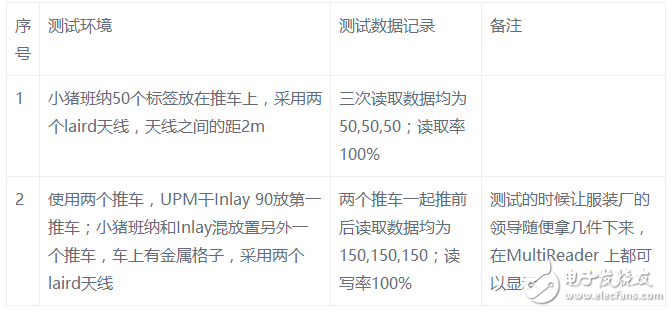
Home technology RFID application case
[ad_1]
First of all, clothing industry manufacturers and retailers in developed countries in Europe and the United States initiated the application of RFID technology in the textile and clothing industries, and now they have achieved gratifying results. Now the application of RFID technology has been expanded to the production, warehousing, logistics and sales of the textile and clothing industries.
In the forefront of RFID technology applications, Marks & Spencer Group PLC in the United Kingdom, Flandre, a high-end garment manufacturer in Japan, Gap Co., Ltd. in the United States, and Gardeur AG, a well-known German clothing manufacturer, are among the leading companies.
The application of RFID technology in the textile and clothing industries, in production, warehousing, logistics and other links, has shown the broad application prospects of RFID technology in the textile industry.

Hengkang Technology is a production-oriented enterprise, which mainly produces bedding, pillowcases, pillows, sheets, etc. Although it uses an ERP system, in production management and warehouse management, data collection uses manual methods, and operating methods seriously affect work efficiency. Many database data cannot be updated in the system in time, and effective management is not implemented in system management. The system cannot accurately grasp the production status and fabric inventory. When workers operate, there is no system to guide them, which is prone to errors. The above-mentioned drawbacks have seriously affected the efficiency of production warehouse management, reduced the management capacity of the production warehouse of the enterprise, increased the management cost of the production warehouse, and restricted the development of the enterprise.
(1) The data in the management information system is unreliable
Although the company spends a lot of manpower and financial resources and is equipped with an advanced ERP system, the data and information sources in the entire information system lack the guarantee of reliability. All data comes from manual input, and errors in manual operation are unavoidable. The occurrence and accumulation of these errors greatly reduces the effectiveness of advanced computer management information systems.
(2) Data collection is time-consuming and laborious, which affects work efficiency
Traditional warehousing uses two-dimensional code technology points, combined with electronic sorting label technology to collect data during the operation to solve the above problems. However, the number of products entering and leaving the warehouse every day is large, the workload is huge, and the production warehouse operations are frequent. When entering and leaving the warehouse in large quantities, the operator needs to scan the barcode on each package one by one to collect the information of the goods in and out of the warehouse. It is time-consuming, laborious, inefficient, and prone to errors due to wrong scanning, missing scanning, and rescanning.
(3) Difficulties in implementing inventory
Inventory is an important operation link in warehouse management. Its purpose is to check the book quantity and the actual inventory quantity, so as to promptly correct the error according to the prescribed procedures after discovering the difference, to ensure that the data on the book can reflect the true situation of the inventory, but the actual situation is However, it is difficult to carry out the inventory work on time and thoroughly, because the premise of the inventory work is to temporarily stop the warehouse in and out operations to ensure that the physical quantity and the book quantity are at the same time point. Such a check is meaningful. However, various environmental conditions determine that the company cannot keep the inventory in a static state for a long enough time to ensure the completion of the inventory.
2. Construction process
2.1 Demand research and analysis stage
In September 2011, the professional technicians of Ziyue Technology Company went to Hengkang Technology to understand the specific business needs, according to the management status of Hengkang Technology, and in-depth analysis of production management, and formed a consistent demand analysis report;
2.2 Project implementation stage
Software development
Card Issuer Software Interface
ERP and RFID application middleware data transmission software
testing on the spot
Before the project is implemented, the customer needs to understand the equipment reading situation, and conduct a test on the spot, using two carts, and the test site is in the factory of Rugao Hengkang Technology Co., Ltd. The test situation and process are described as follows:

Record test data according to each test scene, the following is the test picture.
Put labels in cart 1 (90 pcs):
Put tags in cart 2 (60 pcs):
Hardware installation
Channel installation and testing, as shown below:
Conveyor belt installation and testing, as shown below:
2.3 System operation phase
In March 2012, complete system optimization adjustments and upgrades, key user joint testing, user training, and formal launch.
3. Application value
The benefits of the application of RFID technology in the production process are reflected in the efficiency of the production process, production costs, and quality process control.
Improve the efficiency of the production process: the main production cost factors such as the quantity of raw materials consumed and the time consumption of each process are entered into the back-end database in real time, so that timely and accurate statistics of production costs, output, materials, time consumption, piece rate and other production indicators become a reality , Thereby greatly improving the efficiency of the production process and realizing the visualization of the progress of the production process.
Reduce production costs: production materials and workers use RFID tags for management. Consumed raw materials and labor are registered in real time, and the software system can count the various costs consumed at any time and regularly, and perform cost analysis to achieve the goal of dynamic management of production costs and reduction of production costs.
Strengthen quality control: Real-time registration of the raw materials consumed in each process and the manual use of RFID tags, so as to realize the real-time monitoring of each operation link of the product in the manufacturing process, and realize product quality tracking and quality control.
Realizing make-to-order production: Make-to-order production is an important prerequisite for reducing inventory and supplying on time, while realizing zero inventory and JIT timely production requires rapid response to production. The introduction of RFID tag technology just provides an important technical guarantee for it.
Realizing order quotation: Thanks to the cost data (work time and material consumption) of a single product, it is easy to calculate the profit margin and realize the automation of order quotation calculation.
[ad_2]




